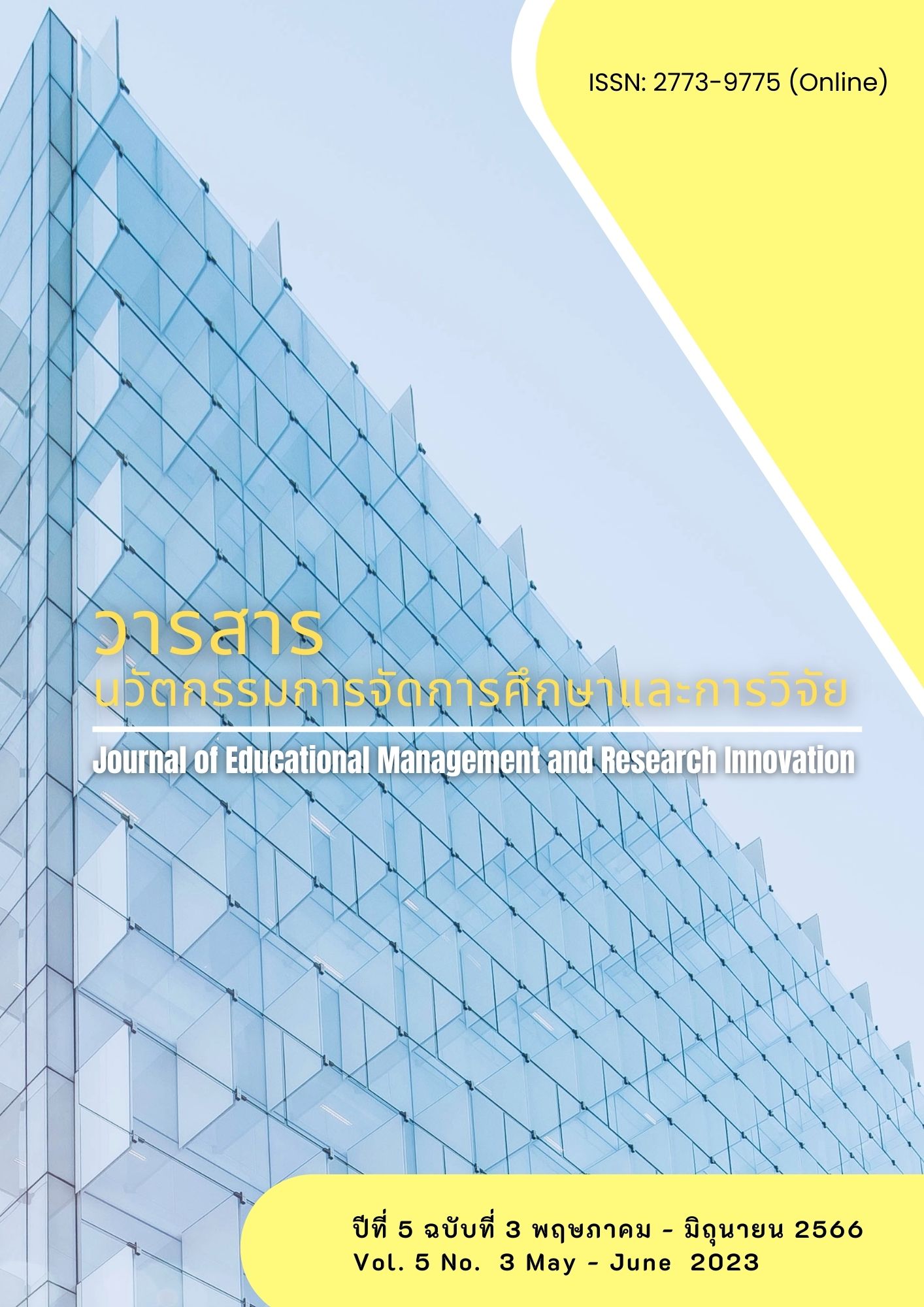Causal Factors Influencing Behavior of Using Social Media in Communication Within Organization of Personnel Srinakharinwirot University
Main Article Content
Abstract
The article aimed to study 1) develop and validate a causal of relationship model of behavior of using social media in communication within organization of personnel Srinakharinwirot University; and 2) study causal factors influencing behavior of using social media in communication within Srinakharinwirot University organization. This study was a quantitative research. The sample was people who have used social media for communication within the organization of personnel of the Srinakharinwirot University of 394 people by convenience sampling technique. The tools used in the research was online questionnaires. The statistics used in data analysis were frequency, percentage, confirmatory factor analysis and structural equation model.
The results of this research were the development of the causal relationship models consisted of 5 components are 1) attitude 2) subject norm 3) perceive behavioral control
4) intention behavioral and 5) usage behavior and the model is consistent with the empirical data to a great extent. The statistic shows CMIN/df = 1.63, CMIN = 332.72, df = 204, GFI = 0.93, AGFI = 0.90, SRMR = 0.02, RMSEA = 0.04. The final is predictive coefficient of 0.62, indicating that the variables in the model can explain the variance of the behavior of using social media in communication within the organization of Srinakharinwirot University by 62 percent. It was found that the Intention Behavioral had respective influence on Usage Behavior. The results of this research are useful for organization, to analyze the behavior of organization who are planning the choice of tools for effective communication within the organization in order to respond to the needs of users within the organization as much as possible.
Article Details

This work is licensed under a Creative Commons Attribution-NonCommercial-NoDerivatives 4.0 International License.
References
กรรณิการ์ คงทอง และรุจิภาส โพธิ์ทองแสงอรุณ. (2561). ความตั้งใจเชิงพฤติกรรมในการใช้เทคโนโลยีของกลุ่มเจเนอเรชั่นเบบี้บูมเมอร์ และเจเนอเรชั่นเอ็กซ์. วารสารวิชาการ สถาบันเทคโนโลยีแห่งสุวรรณภูมิ, 6(2), 43-57.
ญาณินท์ ปฐมกุล, วาทิต อินทุลักษณ์ และ คาล จามรมาร. (2562). ปัจจัยที่มีอิทธิพลต่อความตั้งใจของผู้บริโภคที่เลือกใช้บริการโรงแรมแรมสีเขียวในเขตกรุงเทพมหานคร. วารสารวิจัยและพัฒนาวไลยอลงกรณ์ ในพระบรมราชูปถัมภ์, 14(1), 237-246.
ธนากร โพชากรณ์ และยุวรินธร ไชยโชติช่วง. (2565). อิทธิพลของการสื่อสารแบบปากต่อปากอิเล็กทรอนิกส์ ทัศนคติ การคล้อยตามกลุ่มอ้างอิง และการรับรู้ความสามารถในการควบคุมพฤติกรรมของนักท่องเที่ยวชาวไทยที่มีต่อความตั้งใจเดินทางไปท่องเที่ยวเกาะสมุย จังหวัดสุราษฎร์ธานี. วารสารราชภัฏสุราษฎร์ธานี, 9(2), 119-149.
นิกร ศรีราช. (2564). การสร้างทัศนคติเชิงบวกในการทำงานตามหลักพระพุทธศาสนา. วารสาร มจร สังคมศาสตร์ปริทรรศน์, 10(2), 387-396.
มหาวิทยาลัยศรีนครินทรวิโรฒ. (2565). แนะนำมหาวิทยาลัยศรีนครินทรวิโรฒ. สืบค้นเมื่อ 10 มีนาคม 2565, จาก https://www.swu.ac.th/introduction.php
รัฐธินี สุทธิผลไพบูลย์ และ สมชาย เล็กเจริญ. (2563). ปัจจัยเชิงสาเหตุที่มีผลต่อพฤติกรรมการใช้งาน เว็บไซต์ RTAF.LIVE ในการรับข้อมูลข่าวสารของข้าราชการกองทัพอากาศไทย. วารสารรังสิตสารสนเทศ, 27(2), 6-25.
วัชระ มารุ่งเรือง. (2562). พัฒนาการสื่อสารให้มีประสิทธิภาพด้วยการพัฒนาคน. วารสารพุทธจิตวิทยา, 4(2), 73-78.
สำนักงานพัฒนาธุรกรรมทางอิเล็กทรอนิกส์. (21 สิงหาคม 2565). รายงานผลการสำรวจพฤติกรรมผู้ใช้อินเทอร์เน็ตในประเทศไทย ปี2565. สืบค้นเมื่อ 4 มีนาคม 2566, จาก https://www.etda.or.th /getattachment/78750426-4a58-4c36-85d3-d1c11c3db1f3/IUB-65-Final.pdf.aspx
สุมามาลย์ ปานคำ และ เบญจพร กาทอง. (2565). ปัจจัยเชิงสาเหตุที่มีอิทธิพลต่อพฤติกรรมการใช้แอปพลิเคชัน S.M.A.R.T SOLDIERS ในการรับรู้ข่าวสารของข้าราชการกองทัพบก. วารสารสหวิทยาการมนุษยศาสตร์และสังคมศาสตร์, 5(3), 1087-1103.
สุมามาลย์ ปานคำ และ ภรณ์พัชร์ เนาวรัตน์ธนากร. (2565). ปัจจัยเชิงสาเหตุที่มีผลต่อพฤติกรรมการใช้โซเชียลมีเดียในการสื่อสารภายในองค์กรของบุคลากรสำนักงานคณะกรรมการกำกับกิจการพลังงาน. วารสารสหวิทยาการมนุษยศาสตร์และสังคมศาสตร์, 5(3), 977-992.
อนุวัตร จุลินทร, ดุษฎี โยเหลา, และเพ็ชรัตน์ ไสยสมบัติ. (2562). การวิเคราะห์องค์ประกอบเชิงยืนยันเจตคติต่อความรับผิดชอบต่อสังคมขององค์กรของผู้ประกอบการวิสาหกิจขนาดกลางและขนาดย่อมของไทย. Veridian E-Journal, Silpakorn University (มนุษยศาสตร์ สังคมศาสตร์ และศิลปะ), 12(5), 1376-1395.
อินทิรา ไชยณรงค์. (2561). ทฤษฎีพฤติกรรมตามแผนกับความตั้งใจออกกำลังกายด้วยการเดินในผู้ป่วยภายหลังเกิดโรคหลอดเลือดสมอง. วารสารพยาบาลทหารบก, 19(1), 47-55.
Fretschner, M. (2014). Ajzen’s Theory of Planned Behavior in Entrepreneurship Education Research. Professional and Vet Learning, (3), 249–277.
Hair, J. F., Black, W. C., Babin, B. J. & Anderson, R. E. (2010). Multivariate Data Analysis. (7th ed.). New Jersey: Prentice Hall
Hair, J. F., Hult, G. T. M., Ringle, C. M., & Sarstedt, M. (2014). A Primer on Partial Least Squares Structural Equation Modeling (PLS-SEM). California: Sage Publications.
Hoelter, J. W. (1983). The Effects of Role Evaluation and Commitment on Identity Salience. Social Psychology Quarterly, 46(2), 140–147.
Hu, L.T., & Bentler, P. M. (1999). Cutoff Criteria for Fit Indexes in Covariance Structure Analysis: Conventional Criteria Versus New Alternatives. Structural Equation Modeling, 6(1), 1–55.
Joreskog, K. G., & Sorbom, D. (1984). Advances in Factor Analysis and Structural Equation Models. Lanham: Rowman & Littlefield Publishers.
Kline, R. B. (2011). Principles and Practices of Structural Equation Modeling. (3rd ed.). New York The Guilford Press.
Schreiber, J. B., Stage, F. K., King, J., Nora, A., & Barlow, E. A. (2006). Reporting Structural Equation Modeling and Confirmatory Factor
Analysis Results: A Review. The Journal of Educational Research, 99(6), 323–337.
Schumacker, R. E., & Lomax, R. G. (2004). A Beginner's Guide to Structural Equation Modeling. (2nd ed.). New Jersey: Lawrence Erlbaum Associates Publishers.
Schumacker, R. E., & Lomax, R. G. (2010). A Beginner’s Guide to Structural Equation Modeling. (3rd ed.). Oxfordshire: Routledge.
Thompson, B. (2004). Exploratory and Confirmatory Factor Analysis: Understanding Concepts and Applications. Washington, D. C.: American Psychological Association.
Ullman, M. T. (2001). The Declarative/Procedural Model of Lexicon and Grammar. Journal of Psycholinguistic Research, 30(1), 37–69.

